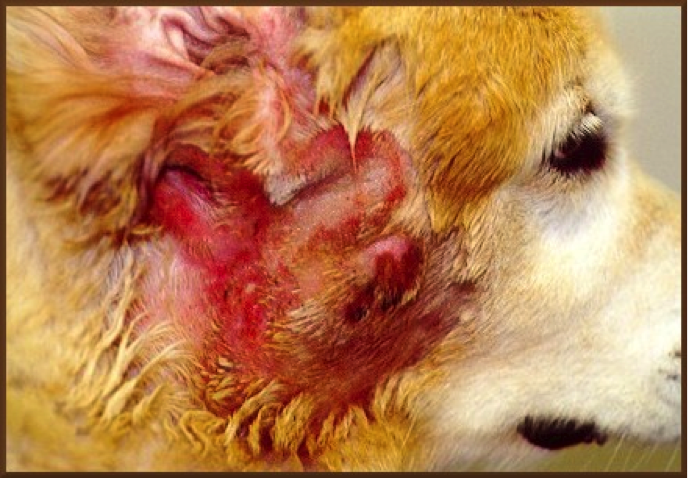The word “hotspot” refers to an area of a dog or cat’s skin that becomes moist and red from excessive licking or scratching. Technically, the proper terminology is focal moist pyodermatitis: these are in a confined area (focal), the skin exudes fluid due to licking or scratching (moist), the fluid often has a lot of white blood cells in it (having the characteristics of pus, hence the prefix pyo-) and the skin is extremely inflamed (red and itchy – dermatitis). The mechanism is the repeated trauma to the skin – licking, chewing and scratching. Most hotspots tend to be obvious as they are red and damp, but in some cases the pus can dry into a scab-like covering stuck in the hair with a raging infection underneath and so can appear dry.
We know how hotspots happen, but sometimes figuring out why takes some detective work. Sometimes we are unable to determine why. Usually, the pet has some inciting cause that makes them itch in a certain area, and often the location of the hotspot can give a clue to the cause. For example a dog with an ear infection may develop a hotspot on the cheek below the affected ear because they have been scratching there. Others develop hotspots on their flank because they have an allergy that is creating a rash on the abdomen and they have been chewing next to it. Others will chew at skin that has been exposed to irritant or has material stuck in the fur.
Essentially, anything that creates an itch could potentially result in a hotspot if it persists long enough and is irritating enough. Prevention of hotspots therefore is best accomplished by preventing the most likely causes of irritation for the pet. However, most hotspots are random events and can be difficult to predict. From a practical standpoint, they are often treated symptomatically when they appear and then the pet is monitored, unless the cause is easily determined and preventable (e.g. fleas, anal sac disease). If the hotspots keep reoccurring, then every effort is made to manage or avoid the potential cause (e.g. allergies).
Hotspot Treatment
Hotspots will tend to self-propagate and grow once they start, in other words regardless of the cause the moist dermatitis will promote a skin infection that will in turn create more inflammation and more chewing (which in turn creates more infection and so on). To properly treat a hotspot we must break the cycle at several points at the same time. First of all, the hotspot must be properly clipped of all remaining hair and superficial scabs and should be cleaned thoroughly with an antiseptic scrub. We use medication to control the inflammation and treat the infection. Depending on the severity and size of the hotspot, this is either done using a topical ointment or spray that contains a steroid and an antibiotic or with an oral steroid and antibiotic. Topical treatment usually lasts 10-14 days while oral treatment is usually for 21 days or more. In addition, most pets will need an e-collar or some other device to prevent them from chewing or scratching the hotspot for the first few days of treatment, until the inflammation dies down.
Most of the time, the pet will allow the clipping and cleaning of the hotspot, but there are some cases where it is so uncomfortable that sedation is required. Alternatively, 1-2 days of oral medications may improve the condition of the hotspot to the point that the pet allows the treatment. The physical cleaning of the hotspot is necessary, however; these will rarely heal with oral medications alone and the hair and scabs must be removed for the topical medication to properly penetrate.
Hotspots can often look a little “scary” once they have been cleaned, but the improvement is rapid and dramatic. Typically within 1-2 days of treatment the skin is looking much better and the pet is much more comfortable with less itchiness. As stated above, the inciting cause (if obvious – allergy, ear infection, irritant, fleas) should be addressed otherwise the pet may have a recurrent episode or another hotspot in a different location.



